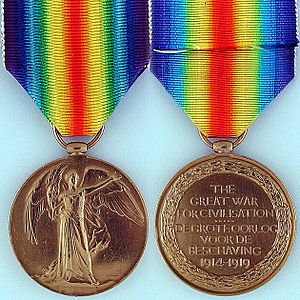Victory Medal (South Africa) facts for kids
Quick facts for kids Victory Medal (South Africa) |
|
|---|---|
 |
|
| Country | |
| Type | Military Campaign medal |
| Eligibility | South African forces |
| Awarded for | Campaign service |
| Campaign(s) | First World War, 1914–1919 |
| Clasps | None |
| Statistics | |
| Established | 1919 |
| South African order of wear | |
| Next (higher) | |
| Next (lower) | |
| Related | |
Ribbon bars without and with MID emblem |
|
The Victory Medal (South Africa) is a special medal given to South African soldiers who fought in World War I. It's South Africa's version of the main Victory Medal (United Kingdom) given by Britain and its other countries. This medal was never given out on its own. Instead, soldiers received it if they had already earned the 1914–15 Star or the British War Medal.
Contents
Why the Medal Was Created
The Victory Medal is also known as the Inter-Allied Victory Medal. It was created to celebrate the Allied victory in the Great War. This idea came from a meeting of Allied countries in March 1919. Each Allied country decided to create a similar medal for their own soldiers. This way, they wouldn't have to swap medals with each other.
Many countries created their own Victory Medals. These included Belgium, Brazil, Cuba, Czechoslovakia, France, Greece, Italy, Japan, Poland, Portugal, Romania, Siam, South Africa, the United Kingdom, and the United States. Most of these medals show a winged figure. This figure represents Nike, the Greek goddess of victory.
The British version of the Victory Medal was given to British soldiers. It also went to soldiers from Canada, Australia, New Zealand, and India. South Africa made its own version. It looked the same on the front as the British one. But on the back, it had words in both English and Dutch. These were the two official languages of South Africa at that time.
Who Received the Medal?
To get this medal, soldiers had to have served in the war. They needed to have been in a war zone between 5 August 1914 and 11 November 1918. The medal was never given alone. You had to have already received either the 1914 Star, the 1914–15 Star, or the British War Medal.
South African soldiers fought in many places during World War I. The Union Defence Forces served in German South-West Africa in 1914 and 1915. The South African Overseas Expeditionary Force fought in Egypt in 1916. They also served in France and Belgium from 1916 to 1918. Other South African troops were in German East Africa and Palestine.
What the Medal Looks Like
The medal is a round bronze disk. It is about 36 millimeters (1.4 inches) wide. It has a shiny finish.
Front of the Medal
The front of the medal shows a winged figure. This is Victoria, the Roman goddess of victory. She is shown with her left arm out. In her right hand, she holds a palm branch.
Back of the Medal
The back of the medal has words written on it. In English, it says "THE GREAT WAR FOR CIVILISATION." Below that, in Dutch, it says "DE GROTE OORLOG VOOR DE BESCHAVING." These two phrases are separated by five dots. At the very bottom, it says "1914-1919." All these words are surrounded by a wreath made of laurel leaves.
Naming
Each medal had the soldier's name stamped onto it.
Ribbon
The ribbon for the medal is about 38 millimeters (1.5 inches) wide. It is made of wavy silk. It has a double rainbow design. This means it starts with violet at the edges. Then it changes through all the colours of the rainbow, ending with red in the middle. The ribbon connects to the medal with a ring.
Special Emblems
Some soldiers were "mentioned in despatches." This means their brave actions were officially noted in reports. If this happened, they wore a small bronze oak leaf on their medal ribbon. A smaller version was worn on the ribbon bar when they weren't wearing the full medal.
Fun Nicknames for the Medals
The three main World War I medals had funny nicknames. These were the 1914 Star (or 1914–15 Star), the British War Medal, and the Victory Medal. Together, they were called Pip, Squeak and Wilfred. These were popular cartoon characters from that time: a dog, a penguin, and a rabbit.
- Pip was the 1914 Star or 1914–15 Star.
- Squeak was the British War Medal.
- Wilfred was the Victory Medal.
If a soldier only received the British War Medal and the Victory Medal, they were called Mutt and Jeff. These were also popular comic strip characters.
How Medals Are Ranked
Medals are worn in a specific order. For the First World War medals, the order is:
- The 1914 Star.
- The 1914–15 Star.
- The British War Medal.
- The Mercantile Marine War Medal.
- The Victory Medal.
- The Territorial War Medal.
South Africa's Medal Order
In 1952, South Africa created its own military awards. These new South African medals were worn before most older British medals. However, the Victoria Cross still came first. Among the World War I medals for South Africans, the Victory Medal is worn after the Mercantile Marine War Medal and before the 1939-1945 Star.
- It comes after the Mercantile Marine War Medal.
- It comes before the 1939-1945 Star.

